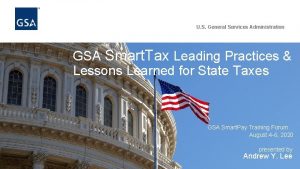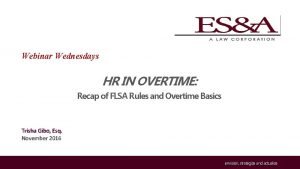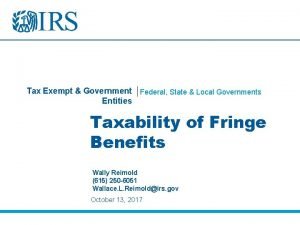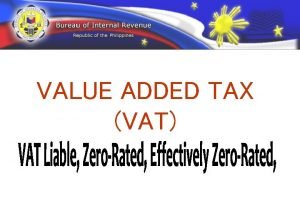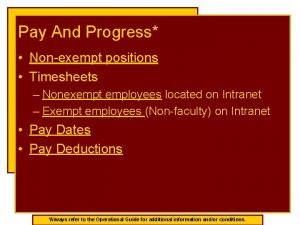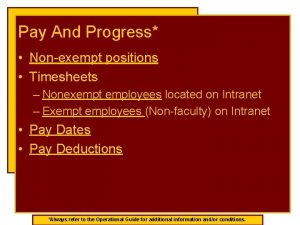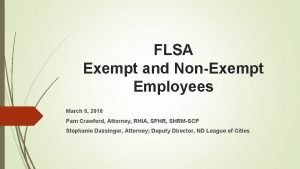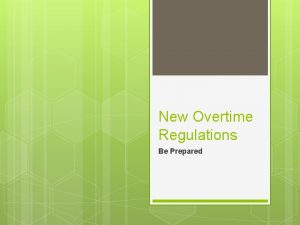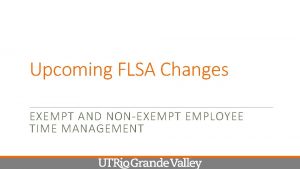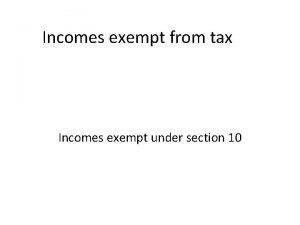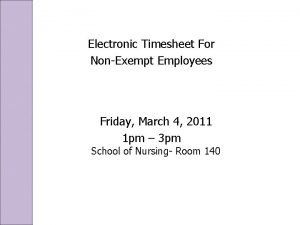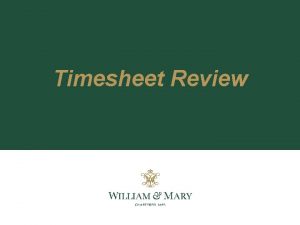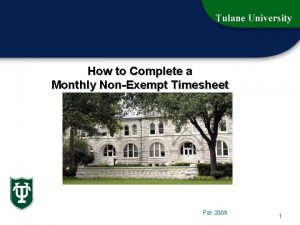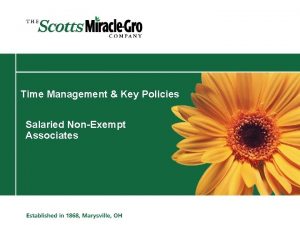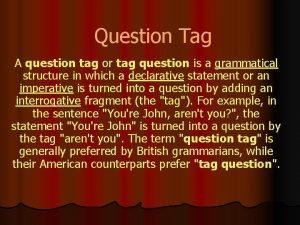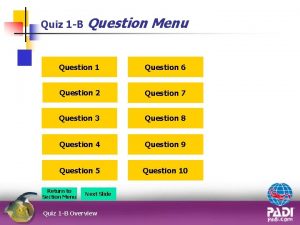Exempt or NonExempt That is the Question July




























- Slides: 28


Exempt or Non-Exempt: That is the Question July 27, 2021

Decoding the FLSA • The federal Fair Labor Standards Act (FLSA) establishes minimum wage, overtime pay, recordkeeping, and youth employment standards affecting employees in the private sector and in Federal, State, and local governments. • Covered non-exempt workers are entitled to a minimum wage of not less than $7. 25 per hour effective July 24, 2009. • Overtime pay at a rate not less than one and one-half times the regular rate of pay is required after 40 hours of work in a workweek. • Many states also have minimum wage laws. In cases where an employee is subject to both state and federal minimum wage laws, the employee is entitled to the higher minimum wage. • For instance, in Virginia, the hourly minimum wage increased to $9. 50 beginning May 1, 2021, increases to $11. 00 on January 1, 2022, and to $12. 00 on January 1, 2023. This supersedes the federal rate.

Why you should care about the FLSA • Employers that do not comply with applicable wage and hour laws face potentially significant legal and financial liability. • Wage and hour claims are some of the costliest employers can face because federal and many state laws provide for collective or class actions on behalf of multiple plaintiffs, back wages, damages, interest, and attorney's fees. • Reduce the risk of legal and financial exposure by auditing your practices! - Payment of minimum wage and overtime compensation, including understanding: • what time is compensable; and • how to properly calculate overtime pay. - Proper classification of workers as: • exempt or non-exempt employees; • independent contractors; or • interns, trainees, or volunteers. - Restrictions on the use of child labor.

Basic Terms CLASSIFICATION • Exempt: An individual who is exempt from the overtime provisions of the FLSA, because he or she is classified as an executive, professional, administrative, or outside sales employee, and meets both the salary test and the duties test. Certain computer professionals may also be exempt. With some limited exceptions, exempt employees must be paid on a salary basis. Hours are not typically tracked. Non-exempt: An individual who is not exempt from the overtime provisions of the FLSA and is therefore entitled to overtime pay for all hours worked beyond 40 in a workweek (as well as any state overtime provisions). Non-exempt employees may be paid on a salary, hourly, or other basis. COMPENSATION • Salaried: An individual who receives the same salary from week to week regardless of how many hours he or she works. Exempt employees must be paid on a salary basis, as discussed above. Non-exempt employees may be paid on a salary basis for a fixed number of hours or under the fluctuating workweek method. Salaried non-exempt employees must still receive overtime in accordance with federal and state laws. Hourly: An individual who receives an hourly wage for work performed. Generally, such individuals, because of the method of payment, are classified as non-exempt and are subject to the overtime provisions of the FLSA. Exempt computer professionals may also be paid on an hourly basis, as could those exempt under the professional exemption, such as teachers, lawyers, doctors, and still retain their exempt status.

The Two Tests to Determine Exempt Status 1. Salary Test • The employee must earn at least $684/week or $35, 568 annually (as of January 1, 2020) • “Computer employees” must be compensated either on a salary or fee basis at a rate not less than $684 per week or, if compensated on an hourly basis, at a rate not less than $27. 63 an hour • Highly compensated employees performing office or non-manual work and paid total annual compensation of $107, 432 or more (which must include at least $684 per week paid on a salary or fee basis) are exempt from the FLSA if they customarily and regularly perform at least one of the duties of an exempt executive, administrative or professional employee identified in the standard tests for exemption. • Other exceptions to the minimum salary requirement include outside sales employees, teachers, doctors, lawyers, business owners, administrative employees in educational establishments, employees in America Samoa and motion picture production industry employees.

Computer Employees The “computer employee” must be compensated either on a salary or fee basis at a rate not less than $684 per week or, if compensated on an hourly basis, at a rate not less than $27. 63 an hour; The employee must be employed as a computer systems analyst, computer programmer, software engineer or other similarly skilled worker in the computer field performing the duties described below; The employee’s primary duty must consist of: • • The application of systems analysis techniques and procedures, including consulting with users, to determine hardware, software or system functional specifications; The design, development, documentation, analysis, creation, testing or modification of computer systems or programs, including prototypes, based on and related to user or system design specifications; The design, documentation, testing, creation or modification of computer programs related to machine operating systems; or A combination of the aforementioned duties, the performance of which requires the same level of skills. The computer employee exemption does not include employees engaged in the manufacture or repair of computer hardware and related equipment. Employees whose work is highly dependent upon, or facilitated by, the use of computers and computer software programs (e. g. , engineers, drafters and others skilled in computer-aided design software), but who are not primarily engaged in computer systems analysis and programming or other similarly skilled computer-related occupations identified in the primary duties test described above, are also not exempt under the computer employee exemption.

The Two Tests to Determine Exempt Status 2. Duties Test An employee who meets the salary test is exempt only if they also perform exempt job duties. These FLSA exemptions are limited to employees who perform relatively high-level work. Whether the duties of a particular job qualify as exempt depends on what they are. Job titles or position descriptions are of limited usefulness in this determination. (A secretary is still a secretary even if s/he is called an "administrative assistant, " and the chief executive officer is still the CEO even if s/he is called a janitor. ) It is the actual job tasks that must be evaluated, along with how the particular job tasks "fit" into the employer's overall operations. There are three typical categories of exempt job duties, called "executive, " "professional, " and "administrative. "

Duties Test - Executive Job duties are exempt executive job duties if the employee 1. regularly supervises two or more other employees, and also 2. has management as the primary duty of the position, and also, 3. has some genuine input into the job status of other employees (such as hiring, firing, promotions, or assignments). The supervision must be a regular part of the employee's job and must be of other employees. Supervision of non-employees does not meet the standard. The "two employees" requirement may be met by supervising two full-time employees or the equivalent number of part-time employees. (Two half-time employees equal one full-time employee. ) "Mere supervision" is not sufficient. In addition, the supervisory employee must have "management" as the "primary duty" of the job. The FLSA Regulations contain a list of typical management duties. These include (in addition to supervision): • • • interviewing, selecting, and training employees; setting rates of pay and hours of work; maintaining production or sales records (beyond the merely clerical); appraising productivity; handling employee grievances or complaints, or disciplining employees; determining work techniques; planning the work; apportioning work among employees; determining the types of equipment to be used in performing work, or materials needed; planning budgets for work; monitoring work for legal or regulatory compliance; providing for safety and security of the workplace.

Duties Test – Executive, continued Determining whether an employee has management as the primary duty of the position requires case-by-case evaluation. A "rule of thumb" is to determine if the employee is "in charge" of a department or subdivision of the enterprise (such as a shift). One handy clue might be to ask who a telephone inquiry would be directed to if the called asked for "the boss. " Typically, only one employee is "in charge" at any particular time. Thus, for example, if a "sergeant" and a "lieutenant" are each at work at the same time (in the same unit or subunit of the organization), only the lieutenant is "in charge" during that time. An employee may qualify as performing executive job duties even if s/he performs a variety of "regular" job duties as well. For example, the night manager at a fast food restaurant may in reality spend most of the shift preparing food and serving customers. S/he is, however, still "the boss" even when not actually engaged in "active" bossing duties. In the event that some "executive" decisions are required, s/he is there to make them, and this is sufficient. The final requirement for the executive exemption is that the employee have genuine input into personnel matters. This does not require that the employee be the final decision maker on such matters, but rather that the employee's input is given "particular weight. " Usually, it will mean that making personnel recommendations is part of the employee's normal job duties, that the employee makes these kinds of recommendations frequently enough to be a "real" part of the job, and that higher management takes the employee's personnel suggestions or recommendations seriously.

Duties Test – Professional The job duties of the traditional "learned professions" are exempt. These include lawyers, doctors, dentists, teachers, architects, clergy. Also included are registered nurses (but not LPNs), accountants (but not bookkeepers), engineers (who have engineering degrees or the equivalent and perform work of the sort usually performed by licensed professional engineers), actuaries, scientists (but not technicians), pharmacists, and other employees who perform work requiring "advanced knowledge" similar to that historically associated with the traditional learned professions. Professionally exempt work means work which is predominantly intellectual, requires specialized education, and involves the exercise of discretion and judgment. Professionally exempt workers must have education beyond high school, and usually beyond college, in fields that are distinguished from (more "academic" than) the mechanical arts or skilled trades. Advanced degrees are the most common measure of this but are not absolutely necessary if an employee has attained a similar level of advanced education through other means (and perform essentially the same kind of work as similar employees who do have advanced degrees). Some employees may also perform "creative professional" job duties which are exempt. This classification applies to jobs such as actors, musicians, composers, writers, cartoonists, and some journalists. It is meant to cover employees in these kinds of jobs whose work requires invention, imagination, originality or talent; who contribute a unique interpretation or analysis. Identifying most professionally exempt employees is usually pretty straightforward and uncontroversial, but this is not always the case. Whether a journalist is professionally exempt, for example, or a commercial artist, will likely require careful analysis of just what the employee actually does.

Duties Test – Administrative The most elusive and imprecise of the definitions of exempt job duties is for exempt "administrative" job duties. The Regulatory definition provides that exempt administrative job duties are: a) office or nonmanual work, which is… b) directly related to management or general business operations of the employer or the employer's customers, and… c) a primary component of which involves the exercise of independent judgment and discretion about… d) matters of significance. The administrative exemption is designed for relatively high-level employees whose main job is to "keep the business running. " A useful rule of thumb is to distinguish administrative employees from "operational" or "production" employees. Employees who make what the business sells are not administrative employees. Administrative employees provide "support" to the operational or production employees. They are "staff" rather than "line" employees. Examples of administrative functions include labor relations and personnel (human resources employees), payroll and finance (including budgeting and benefits management), records maintenance, accounting and tax, marketing and advertising (as differentiated from direct sales), quality control, public relations (including shareholder or investment relations, and government relations), legal and regulatory compliance, and some computer-related jobs (such as network, internet and database administration).

Duties Test – Administrative, continued The "staff" or "support" work must be office or nonmanual and must be for matters of significance. Clerical employees perform office or nonmanual support work but are not administratively exempt. Nor is administrative work exempt just because it is financially important, in the sense that the employer will experience financial losses if the employee fails to perform competently. Administratively exempt work typically involves the exercise of discretion and judgment, with the authority to make independent decisions on matters which affect the business as a whole or a significant part of it. Questions to ask might include whether the employee has the authority to formulate or interpret company policies; how major the employee's assignments are in relation to the overall business operations of the enterprise (buying paper clips versus buying a fleet of delivery vehicles, for example); whether the employee has the authority to commit the employer in matters which have significant financial impact; whether the employee has the authority to deviate from company policy without prior approval. An example of administratively exempt work could be the buyer for a department store. S/he performs office or nonmanual work and is not engaged in production or sales. The job involves work which is necessary to the overall operation of the store -- selecting merchandize to be ordered as inventory. It is important work, since having the right inventory (and the right amount of inventory) is crucial to the overall well-being of the store's business. It involves the exercise of a good deal of important judgment and discretion, since it is up to the buyer to select items which will sell in sufficient quantity and at sufficient margins to be profitable. Other examples of administratively exempt employees might be planners and true administrative assistants (as differentiated from secretaries with fancy titles).

Duties Test – Administrative, continued Merely clerical work may be administrative, but it is not exempt. Most secretaries, for example, may accurately be said to be performing administrative work, but their jobs are not usually exempt. Similarly, filing, filling out forms and preparing routine reports, answering telephones, making travel arrangements, working on customer "help desks, " and similar jobs are not likely to be high-level enough to be administratively exempt. Many clerical workers do in fact exercise some discretion and judgment in their jobs. However, to "count" the exercise of judgment and discretion must be about matters of considerable importance to the operation of the enterprise as a whole. Routinely ordering supplies (and even selecting which vendor to buy supplies from) is not likely to be considered high- enough to qualify the employee for administratively exempt status. There is no "bright line. " Some secretaries may indeed be high-level, administratively exempt employees (for example, the secretary to the CEO who really does "run his life"), while some employees with fancy titles (e. g. , "administrative assistant") may really be performing nonexempt clerical duties.

Then what…. If the employee seems to pass BOTH the salary test and the preliminary exemption criteria review, then a thorough job analysis of the duties actually performed by each employee may be necessary. 1. 2. 3. 4. 5. 6. Review minimum qualifications established for the job, including education, on-the-job training and experience. Gather organizational charts. Review prior job descriptions and related documentation. Confirm with managers that duties and qualifications are accurate. Conduct workflow reviews—where does this position fall in the workflow, and what role does is play? Gather prior performance reviews which document duties and responsibilities. If little is known regarding the history of a position or it has been inadequately documented, an employer should consider conducting a review of the position to bring it up to date. Recommended activities may include direct job duty observation, work function or work breakdown analysis, group or peer review of occupants sharing the classification, job banding/job progression plans, and analysis of any other metrics that are available.

An exempt position must pass BOTH the salary test and the duties tests. Job titles are insufficient to determine exempt status.

Overtime Reminders Non-exempt employees must receive overtime pay for hours worked over 40 per workweek at a rate not less than one and one-half times the regular rate of pay. The regular rate of pay is the employee’s hourly rate plus other non-overtime wages paid or allocated to that workweek (e. g. , commissions, bonuses, and/or hazard pay), minus any applicable federal exclusions (e. g. , gifts, reimbursements for travel expenses, holiday pay, PTO, sick leave, and other paid time off), divided by the total number of hours worked in that workweek. Some states have overtime laws (aka Virginia). In cases where an employee is subject to both the state and federal overtime laws, the employee is entitled to overtime according to the higher standard (i. e. , the standard that will provide the higher overtime pay). https: //www. dol. gov/agencies/whd/flsa

The Non-Exempt Salaried Route An employer may opt to pay a non-exempt employee on a salary basis instead of an hourly wage, such an arrangement typically is advantageous only for the employee. Employers are not relieved of the obligation to track hours worked for non-exempt employees paid a salary and must continue to pay overtime as required. In some environments where overtime is very rare and timekeeping is very simple, a salary may be administratively easier; however, employers should not make the false assumption that paying a salary means an employee does not have to keep records of actual hours worked. Even very small amounts of overtime hours and unauthorized overtime must be tracked and compensated for all non-exempt employees.

Fluctuating Workweek Method Under the fluctuating workweek method, non-exempt salaried employees receive a set weekly salary no matter how many hours they work, plus additional overtime pay when they work more than 40 hours in one workweek. In other words, the employee’s weekly salary does not change whether the employee works 30 hours, 40 hours, or more. In weeks when the employee works more than 40 hours, the employee receives additional overtime pay for each hour of work over 40. Under the federal fluctuating workweek method, overtime pay is based on the average hourly rate produced by dividing the employee’s fixed salary and any non-excludable additional pay by the number of hours actually worked in a specific workweek. The average hourly rate will change from week to week depending on how many hours the employee actually worked. The employee then receives at least an additional 0. 5 times (“half time”) that rate for each hour worked beyond 40 in the workweek. Some states have changed this calculation…. .

The Math Federal Method Under the FLSA, a non-exempt salaried employee that makes $1, 000 per week and worked 50 hours that week would have a regular rate of $20 per hour ($1, 000 / 50). Thus, all overtime should be paid to that employee at $30 an hour (1. 5 times $20). $1, 000 / 50 = $20 regular rate of pay $20 x 1. 5 = $30 Straight time earnings = $1, 000 Overtime earnings = $300 (10 x $30) Total earnings = $1, 300

Other things to consider… 1. Review state wage/hour laws for those states in which the organization operates to ensure there is no conflict with state laws 2. Capture payroll costs and budgetary needs and evaluate whether costs and budgetary considerations will be best met by raising incumbent salaries to retain exempt status (provided duties test is met), budgeting for overtime costs or hiring additional staff to eliminate the need for overtime. 3. Ensure HRIS systems are updated to accurately reflect employee’s exempt/non-exempt classifications. 4. Review and honor collective bargaining agreements, where possible.

Virginia Overtime Wage Act (VOWA) Beginning on 7/1/2021, Virginia employers with non-exempt, salaried employees will be subject to new state overtime pay requirements. Previously, Virginia had been content to rely on the over time pay requirements of the federal Fair Labor Standards Act (FLSA). As of July 1, 2021, Virginia employers must calculate a non-exempt salaried employee’s regular rate of pay as follows Employees Total Weekly Compensation / 40 Hours = Regular Rate of Pay Regardless of how many hours the employee actually worked that week.

The Math Virginia Method Let’s take our previous example: A non-exempt salaried employee that makes $1, 000 per week and worked 50 hours that week. As of July 1 in VA, a non-exempt, salaried employee’s regular rate of pay is determined by dividing $1, 000 by 40 – regardless of how many hours they actually worked. $1, 000 / 40 = $25 regular rate of pay $25 x 1. 5 = $37. 50 Straight time earnings = $1, 000 Overtime earnings = $375 (10 x $37. 5) Total earnings = $1, 375 as opposed to $1300 under FLSA

Virginia Overtime Wage Act (VOWA) VOWA departs from the FLSA in three ways that could increase your liability, including: • Changing the calculation of regular rate of pay for non-exempt salaried employees • Giving employees three years to bring lawsuits from the date of the violation, regardless of whether the violation was willful • Omitting good faith defenses for employers and providing for potential triple damages and interest

Statute of Limitations Under the FLSA, suits must be filed within two years, or within three years if the employee can prove that the violation was “willful. ” Under VOWA, all employees have three years to file suit regardless of whether or not the violation was “willful. ” Employees can recover back wages for that three-year period.

FLSA and VOWA Overtime Claims • Employers may mistakenly classify employees as "exempt" from the FLSA overtime requirements. These misclassified exempt employees (who are really non-exempt) often work regular ("on-the-clock") hours in excess of the FLSA overtime thresholds, as well as compensable "off-the-clock" hours. • Employers may fail to identify, record, or compensate "off-the-clock" hours spent by employees performing compensable, job-related activities. Examples: Employees may perform a variety of potentially compensable job-related activities during their "off-theclock" time, such as: taking work home, making/receiving job-related telephone calls at home, working through lunch, working before or after regular shifts taking care of workrelated equipment. • Employers may fail to include "wage augments" such as longevity pay when calculating an employee's overtime rate.

Your questions from last week… • Are we required to track hours for exempt employees? - No • Has DP already set up new earnings codes to reflect these changes? – Yes, and no. • How is exempt determined? Is this changed by VOWA? – See above, and no. • Can you give examples of differences between exempt and non-exempt based on job title? – See above. • Do you have a link or resource? – Yes, check out the PDF linked just below this presentation once it’s posted on our website by close of business today!

Submit your questions now using the Q&A function on your screen Or submit questions to questions@dominionpayroll. co m
 Costas de espaã±a
Costas de espaã±a Thơ thất ngôn tứ tuyệt đường luật
Thơ thất ngôn tứ tuyệt đường luật Tôn thất thuyết là ai
Tôn thất thuyết là ai Ngoại tâm thu thất chùm đôi
Ngoại tâm thu thất chùm đôi Chiến lược kinh doanh quốc tế của walmart
Chiến lược kinh doanh quốc tế của walmart Gây tê cơ vuông thắt lưng
Gây tê cơ vuông thắt lưng Block nhĩ thất độ 3
Block nhĩ thất độ 3 Tìm độ lớn thật của tam giác abc
Tìm độ lớn thật của tam giác abc Sau thất bại ở hồ điển triệt
Sau thất bại ở hồ điển triệt Thể thơ truyền thống
Thể thơ truyền thống Hãy nói thật ít để làm được nhiều
Hãy nói thật ít để làm được nhiều Gsa tax exempt form florida
Gsa tax exempt form florida What is mean by virgin
What is mean by virgin E595 tax exempt form
E595 tax exempt form Are local governments tax exempt
Are local governments tax exempt Non assessable income
Non assessable income Are city governments tax exempt
Are city governments tax exempt Exempt development code
Exempt development code Persons exempt from vat
Persons exempt from vat June 22 to july 22
June 22 to july 22 Sergei korolev
Sergei korolev 2001 july 15
2001 july 15 Growth of leaf yeast experiment
Growth of leaf yeast experiment July 4 sermon
July 4 sermon May 1775
May 1775 Poppies in july poem
Poppies in july poem July 1-4 1863
July 1-4 1863 July 12 1776
July 12 1776 January/february may/june
January/february may/june











